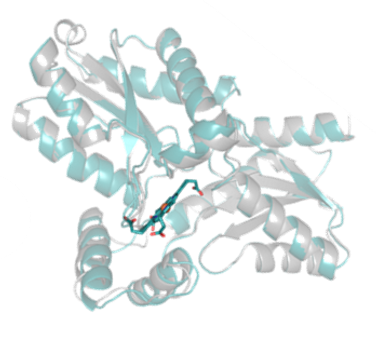Biochemistry of actinobacterial coproporphyrin ferrochelatase from Corynebacterium diphtheriae
PRINCIPAL INVESTIGATOR: Stefan HOFBAUER
Background.
Prokaryotic heme b biosynthesis has been studied extensively in the past decades. While most diderm bacteria synthesize the iron containing cofactor analogously to mammals via the so-called "protoporphyrin-dependent" (PPD) pathway, monoderm organisms utilize a different pathway, the "coproporphyrin-dependent" (CPD) route (Dailey et al., 2015;Falb et al., 2023). In the CPD as well as in the PPD pathway a ferrochelatase is needed to incorporate ferrous iron into the porphyrin ring. Importantly, the respective porphyrin substrate is different in each pathway. Coproporphyrin III has two more propionate groups than protoporphyrin IX. These two additional propionates potentially have a major impact to substrate-enzyme interactions and other structural properties translating to functional aspects (Gabler et al., 2022;Dali et al., 2023). Until 2015 all coproporphyrin ferrochelatases of monoderm bacteria were studied in the believe to be protoporphyrin ferrochelatases and consequently all biochemical and biophysical studies were performed with a non-physiological substrate. In this project we aim at understanding of this recently identified CPD heme biosynthesis pathway. Further some actinobacterial coproporphyrin ferrochelatases, like the representative from Cornyebacterium diphtheriae, contain a [2Fe-2S] cluster of yet unknown function (Weerth et al., 2021).
First kinetic and structural data of the wild-type enzyme will be a perfect basis for further structural and functional studies of CpfC variants, in which residues essential for catalysis, for substrate binding and stabilization, as well as the iron-sulfur cluster coordination will be altered. Also, the interaction with other proteins, delivering the ferrous iron or producing the other substrate, coproporphyrin III, or receiving the product, coproheme, will be investigated.

Aims and methods.
Monomeric CpfC from Corynebacterium diphtheriae (wild-type and variants) will be heterologously expressed in E. coli. Based on structural data site-directed mutagenesis of distal and proximal amino acids will be performed. Emphasis will be placed on amino acids involved in coproporphyrin III, coproheme and [2Fe-2S] cluster binding and residues involved in coordinating incoming ferrous iron and other regulatory sites.
Wild-type and mutant proteins will be characterized by a broad set of biochemical/physical methods including (i) X-ray crystallography, (ii) detailed spectral analysis (UV-Vis, electron paramagnetic resonance and resonance Raman spectroscopy) of proteins, and protein-based radicals in different redox- and spin-states (in cooperation with Giulietta SMULEVICH, Department of Chemistry, University of Florence, Italy), (iii) time-resolved multi-mixing UV-vis stopped-flow studies in order to analyze the kinetics of substrate binding and iron insertion, (iv) spectroelectrochemical studies (in cooperation with Gianantonio BATTISTUZZI from the Department of Chemistry, University of Modena and Reggio Emilia, Italy). These methods will provide valuable insight into the mechanism of coproheme decarboxylation.
Dailey, H.A., Gerdes, S., Dailey, T.A., Burch, J.S., and Phillips, J.D. (2015). Noncanonical coproporphyrin-dependent bacterial heme biosynthesis pathway that does not use protoporphyrin. Proc Natl Acad Sci U S A 112, 2210-2215.
Dali, A., Gabler, T., Sebastiani, F., Destinger, A., Furtmuller, P.G., Pfanzagl, V., Becucci, M., Smulevich, G., and Hofbauer, S. (2023). Active site architecture of coproporphyrin ferrochelatase with its physiological substrate coproporphyrin III: Propionate interactions and porphyrin core deformation. Protein Sci 32, e4534.
Falb, N., Patil, G., Furtmuller, P.G., Gabler, T., and Hofbauer, S. (2023). Structural aspects of enzymes involved in prokaryotic Gram-positive heme biosynthesis. Comput Struct Biotechnol J 21, 3933-3945.
Gabler, T., Sebastiani, F., Helm, J., Dali, A., Obinger, C., Furtmuller, P.G., Smulevich, G., and Hofbauer, S. (2022). Substrate specificity and complex stability of coproporphyrin ferrochelatase is governed by hydrogen-bonding interactions of the four propionate groups. FEBS J 289, 1680-1699.
Weerth, R.S., Medlock, A.E., and Dailey, H.A. (2021). Ironing out the distribution of [2Fe-2S] motifs in ferrochelatases. J Biol Chem 297, 101017.
